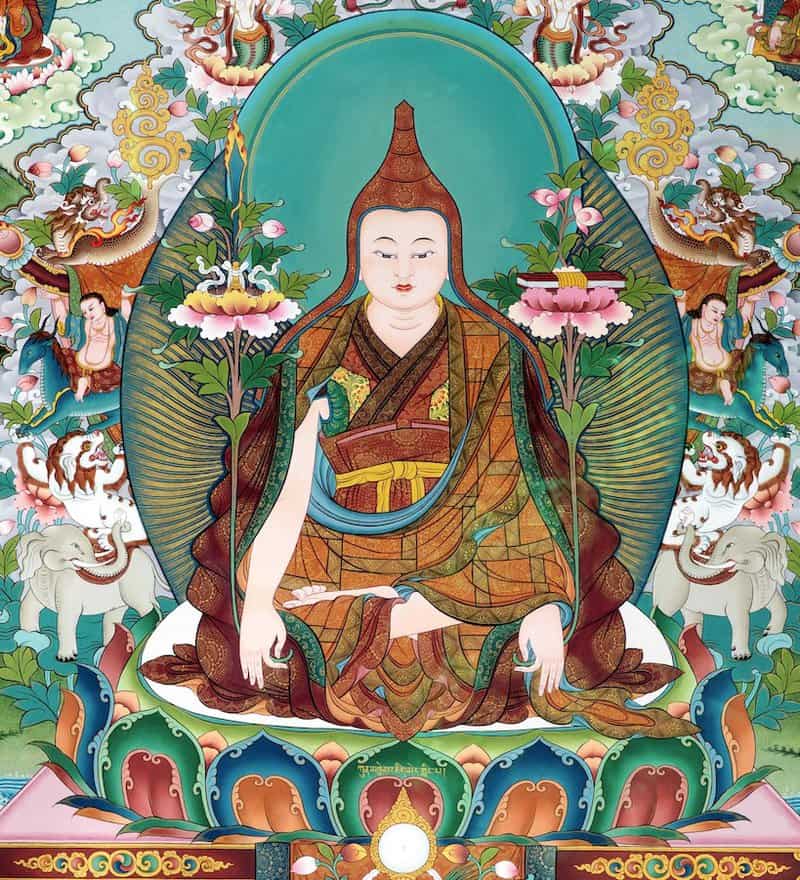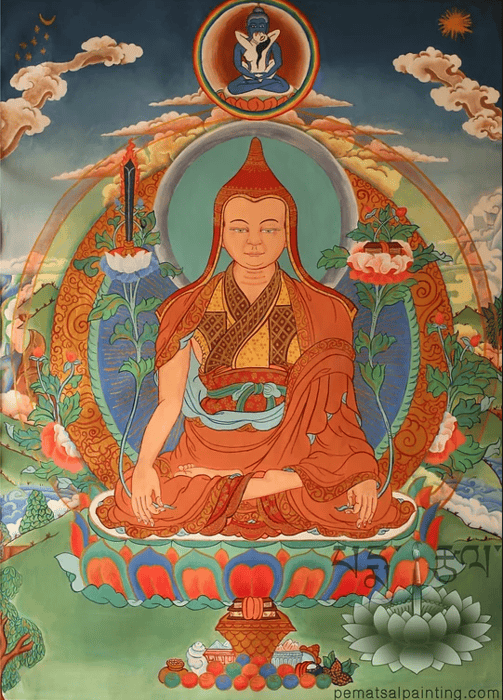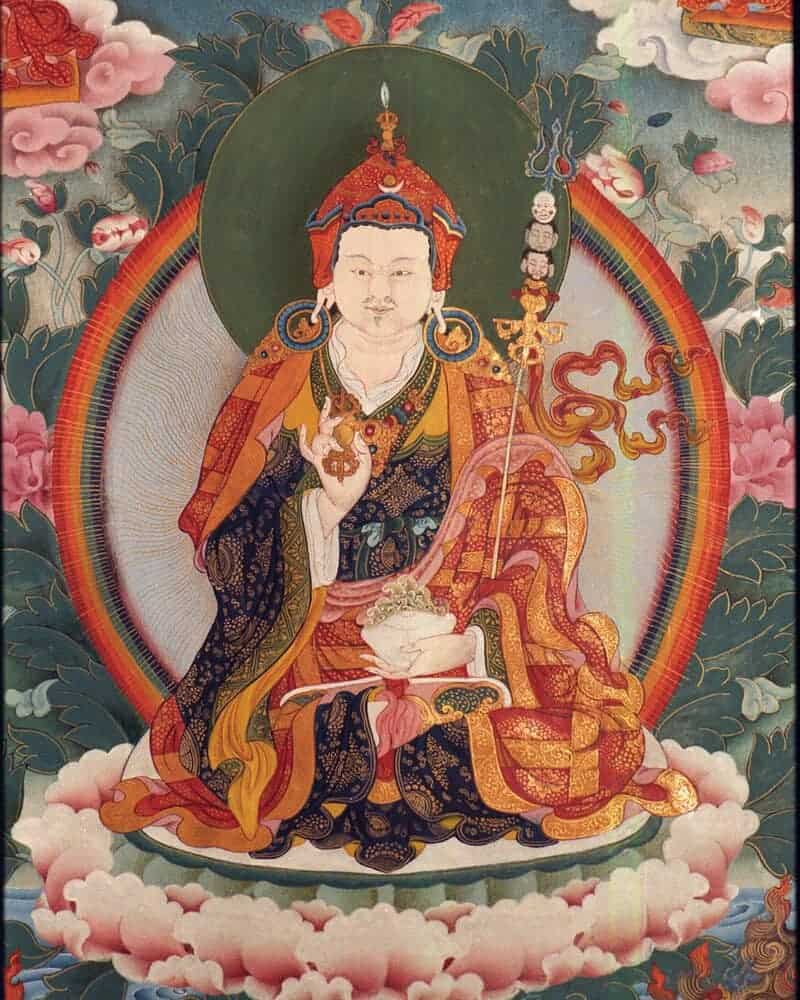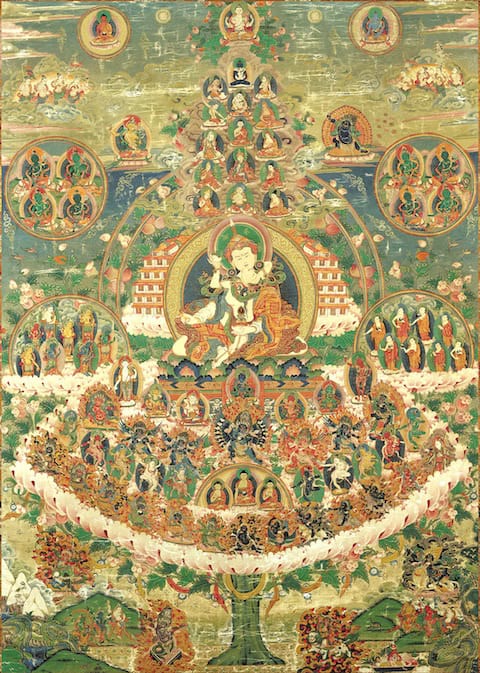The Six Vajra Verses of Vairotsana
Hey, Mahasattva, Magnificent Being, listen!
The nature of multiplicity is Nondual
and things in themselves are pure and simple;
being here and now is construct-free
and it shines out in all forms, always all good;
it is already perfect, so exertion is redundant
and spontaneity is ever immanent.
Vairotsana
Original Perfection: Vairotsana’s Five Early Transmissions
Translation and Commentary by Keith Dowman
The siren call of the groundless ground
I am drawn over and over again to the early teachings of Dzogchen. They appear so simple, pure, and direct. They speak to me in a way which is like silence speaking to silence. Like stillness reflecting silence. Like awareness aware of awareness.
Not the graduated path of later Dzogchen, as it was increasingly assimilated into Vajrayana, and took on many of its guises. Just pointing directly to this, and rejecting all paths and practices – just this.
I have no skin in this particular game, and no wish to combat with those who are deeply learned in the Dzogchen tradition, who would point out how mistaken I am. I don’t have a philosophical position that says no path, no Vajrayana basis, no practice. And you could even say that I do practice in a sense, if merely resting in Rigpa is a considered a practice?
But these early Dzogchen teachings (from what is known as the Semde series) say in no uncertain terms that all practice is an error – you cannot get anywhere, you cannot improve anything, everything is already perfect and complete. The Great Perfection, the Great Completion.
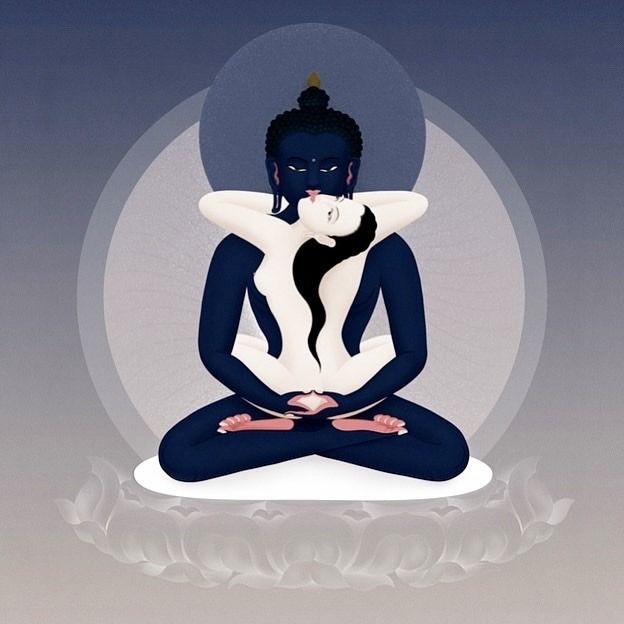
The end of seeking
Something speaks very deeply, and something hears, no – knows very deeply in response. Like dropping your clothes to the floor. Let go. Or putting a weight down. Let go. Or of finally, finally, letting go of the struggle, the struggle that seemed like nobility, that was a need so deeply embedded it was my very soul. Let go of seeking Liberation!
No, there’s no need to seek. It’s nowhere else. And it’s not different to Samsara in nature. Drop it all. Let go. Rest in minds nature. Rest in primordial purity. Rest in spontaneous presence.
All is deeply, deeply well.
Vairotsana the great Lotsawa
Vairotsana (also known as Vairocana / Berotsana) was the greatest of all the translators (Lotsawa), who worked with Indian scholars and pandits to translate the Dzogchen teachings into Tibetan. He lived some time in the eighth or ninth centuries CE. He received teachings from Shri Singha, and also from Manjushrimitra, who had appeared to him in his wisdom body. He is considered one of the main masters to bring Dzogchen to Tibet, along with Padmasambhava and Vimalamitra.

The transmission of the Cuckoo’s song
Vairotsana’s key transmission to us is the Five Early Translations. These are found in the Collected Tantras of Vairotsana compiled in the 12th century CE. They were then assimilated into The Supreme Source / Kunjed Gyalpo which become the encyclopedic Dzogchen Tantra of the early Dzogchen transmission. Thus the Cuckoo’s Song of Awareness became part of the Kunjed Gyalpo.
The Cuckoo’s Song of Awareness (Rig pa’i Khu Byug) is also known as the Six Vajra Verses of Vairotsana. It is considered to be the root text of the Dzogchen Mind series, the Semde series.
In Tibet the Cuckoo is considered to be imbued with magical powers – no ordinary bird. The song it delivers is no ordinary song. As the sound of the song of the Cuckoo heralds the arrival of Spring, so this song heralds the arrival of the teachings of Dzogchen, and introduce us to the nature that Dzogchen directly points to.

The Dochu commentary
This is a prose commentary on the Six Vajra Verses, which provides the most beautiful short explication of the song. How wonderful this commentary is. It superbly tells the story of the song, and how each aspect leads seamlessly to the next.
How crystal clear the meaning of Vairotsana’s teaching. How precisely this diamond cutter of a transmission, which cuts through Marigpa and reveals the pristine purity of mind’s nature in all its radiant dancing.
All experience, the entire phantasmagoria of the six senses, the diverse multiplicity of existence, in reality is without duality.
Even if we examine the parts of the bodhi-matrix in the laboratory of the mind, such specifics are seen to be illusive and indeterminate.
There is nothing to grasp and there is no way to express it.
The suchness of things, their actuality, left just as it is, is beyond thought and inconceivable and that is the here and now.
Yet diversity is manifestly apparent and that is the undiscriminating, all-inclusive sphere of the all-good Buddha, Samantabhadra.
Total perfection has always been a fact and there has never been anything to do to actuate this immaculate completion. All endeavour is redundant.
What remains is spontaneity and that is always present as our natural condition.
The Dochu commentary
The salutation
Hey, Mahasattva, Magnificent Being, listen!
This translation of the song begins with a beautiful salutation. The salutation sometimes speaks to me as if it is from Samantabhadra, who symbolises this primordial purity, and as if addressed directly to Vajrasattva, who gives birth to the whole gloriously magical display of appearances.
You could say that the Dharmadhatu, the realm of space, of emptiness, is saluting the basic, naked awareness that is Vajrasattva, who births all that arises and ceases.
Other translations make clear though that it’s Samantabhadra who is being solely referred to here. Unlike earlier Buddhist Tantras where Vajrasattva is the primordial figure, here it is Samantabhadra. It almost reads as Samantabhadra saluting Samantabhadra, as if reflecting in a mirror:
Salutation! Supreme Abundance!
Homage to the Transcendent Victorious Samantabhadra’s
Vajra body, speech and mind of great bliss.
English translation: Karen Liljenberg
But equally, you could say that Samantabhadra is addressing us directly, us who encounter this song, and telling us that we are glorious Samantabhadra, the great being, the incomparable being, just as we are, right now. What a magnificent way to be addressed!
Whatever is expressed from that groundless, ground of being, the Dharmadhatu, never strays from that nature, whether of Dharmakaya essence – emptiness, Sambhogakaya nature – luminosity, or Nirmanakaya expression – appearances.
The nature of diversity is Nondual
The nature of multiplicity is Nondual
Whatever appearances arise in mind, whether thoughts, emotions, feelings, perceptions – anything whatsoever – they never stray from the fundamental nature of open, spacious emptiness. Our deluded minds see solid appearances, a solid world, a solid mental state. Our moods coagulate into dense blocks of solidity, which appear anything but empty. At times we may become still and have an experience of awareness, as those thoughts, emotions and perceptions become less what we are (I am angry, I am happy), and appear more like clouds within a wider sky.
At times we sense awareness and sense the objects within awareness. They seem different, distinct, maybe even one pure, one sullied?
But let the mind rest more, let awareness open, and see minds nature. Then you see, without doubt, that all that appears to arise in mind is none other than that same nature – vast emptiness. Those appearances are like a shadow – they appear on the ground, but they have no more substance that a shadow. And similarly to a shadow, they leave no mark on the ground when they pass. They distinctly seem to manifest – we know they are there, yet they are never anything other than emptiness itself, expressing itself in unceasing display. There may be an endless variety of appearances, but they never stray from emptiness, whatever their particular manifestation.
Awareness and appearances are inseparable. They are not distinct. They are nondual. This display of appearances, this groundless ground – nondual, not-different. Not different from emptiness, not different from each other. Sameness as multiplicity.
Things in themselves are free from complexity
and things in themselves are pure and simple;
When you rest in Rigpa you see that all appearances have no complexity, and are free of conceptual elaboration. When there’s a thought, or an emotion, or perception you see that these are so transparent, so simple in their purity that they are nondual with the groundless, ground in which they arise. The multiplicity of things that come and go in our experience is not like cutting something up or slicing it up. There remains this indivisible purity of empty awareness, and appearances are a mere magical display with no substance.
Moreover, however many appearances multiply from that basic spacious ground, they remain entirely illusive and indeterminate.
Sometimes the word ‘being’ feels closer to this – just pure, simple being-ness. I know this taught is fraught with difficulty in a Buddhist context, as it usually connotes being as against non-being. Something that persists, like a self or soul. How utterly Hindu! Yet this being-ness I speak of is trying to describe the mere hum of luminosity that endlessly expresses itself with the display of appearances. They are just a glow, a hum, a radiance from this simple, pure, being-ness.
It’s not something, it’s not persistent, it’s not coming and going – it’s beyond all of that. A being here-ness. There’s no subject and object – this simple, pure presence is nondual.
It’s naked, it’s simple, it’s pure. All of it – all of the display and the mirror which reflects the display.
Suchness is non-conceptual
being here and now is construct-free
This ground is non-conceptual. As soon as we think about it, try to analyse it, make it into an object, then we fabricate something and that something isn’t what we were originally aware of, aware in, aware as, aware from. There is no way to express either the ground, or the multiplicity – words always fail.
If you have got something then that isn’t it – you’re on the wrong track. It’s utterly groundless, yet has this potentiality, this radiance that manifests as this endless display. Not that the display is anything at all either. Everything you experience is not separate from their own ground. This suchness is not a thing, not conceptual, not a construct. You could call it an open state, though it’s not a state. It’s just the ocean and the wave, the empty essence and the luminosity which radiates as appearances. The waves are not separate from the ocean, and their nature is not different from the ocean.
Look now, at this.
However it is, it’s just this, always unfolding and yet beyond time and space.

All good, always
and it shines out in all forms, always all good;
There is nothing you can do to improve all that appears to mind, all these appearances. Indeed, they are already perfect, always good. They are empty, pure, luminous display – how could you improve on that?
Samantabhadra is apparent in forms. That empty essence manifests as magical display. You can directly know Samantabhadra nature in the forms – they are none-other than emptiness, none other than the Dharmadhatu in expression.
Always good, always perfect. The all-inclusive sphere of the all-good Buddha, Samantabhadra is undiscriminating. Nothing that can be expressed is rejected. There’s no judgement. Good or bad, ugly or beautiful, none are any more or less Samantabhadra in nature. They are the creation of Samantabhadra. In the same way as the reflections in a mirror are created by the mirror. Kun-tu bzang-po (Samantabhadra ) shines forth in all forms. Always good.
Abandon the sickness of striving
it is already perfect, so exertion is redundant
How painful was this striving to go beyond suffering? How painful indeed the seeking, the journey, the endless work to be done to find liberation?
Like a sickness we can’t seem to shake, however good the results of practice. There’s something to do, something to cultivate, something to overcome.
When we are unaware, and think the issue is the world out there we blame it all on the world. We seek to arrange an endless array of circumstances so that we will always be happy, on and on and on.
Yet for some beings something happens, and they wake up to the nature of the game they are seemingly playing. They see that this is a game they cannot win, that like a gambler they are chained to the game, an endless enterprise in trying to keep things right.
Maybe you get lucky, and something drops – something that tells you it is craving this creates suffering. Then off you go on the spiritual journey, seeking to end suffering and find complete freedom and liberation. If you are more lucky still it becomes the most important thing in your life, the only thing in your life – the need to end this suffering and find this liberation.
It may become a sickness, a shadowside to the journey to freedom, a shadow that follows you in your wake, and falls on you throughout. The seeking and the seeker. Never mind there’s no self, nobody who is seeking, nothing to find. You travel, on and on, looking for freedom. Cultivating, meditating, striving, however gently.
The average mind wants and don’t want – and makes effort to get what it want. The spiritual mind cultivates peaceful states, and seeks to find the wisdom that brings peace. Whether course or most high, all striving, all effort is a sickness and it won’t bring about a cure. The exertion itself is the disease, trying to create something that’s other than simply this.
Did you not know you were the fool with a jewel sewn into your robe all this time, which going around ever hungry and seemingly poor? Do you not know we are already perfect, already complete as we are? Ever empty, ever wakeful, ever expressive in endless display? The mind itself is already pure, it doesn’t matter what arises in mind. The mirror is not tainted by reflections, however they are. No trace is left in this open sky like nature of mind. So why would you struggle to cultivate and purify?
The mirror is ‘full’ of its reflections, yet is not altered in any way by them. The mirror has a clarity that reflects, but it remains forever untouched and untainted, regardless. Does the mirror make an effort to reflect? What benefit is there for us to strive and struggle – we never leave Samantabhadra in truth.
Our nature is perfect completeness, and it doesn’t need us to actualise this. No amount of endeavour will improve our nature a single jot.
Look now at mind, this timeless, open spaciousness, this simple pure being-ness, utterly transcendent, yet imminently creating the endless illusory display of appearance. Look now – what can be other than what it is? Why are we so hooked on something always needing to be done. If only it was like this, more like that, not so much this way. We always want to do something. Is this not a sickness, seeking to change what is?
This doesn’t mean there isn’t action in the world, and we are zoned out in our own comfort zone, while the world suffers. But it does mean that the need to do things, the thirst to manipulate, modify and change this runs so deeply in our veins, and makes it hard for us to see this open, spacious dimension that is our true groundless nature. That everything is complete in itself in this open presence which is all good in itself.
Spontaneous abiding
and spontaneity is ever immanent.
We can let go of this sense of lack that ultimately must underlie the sickness of striving. The Dharmadhatu is always open, always hospitable to all that arises. Be that openness, that hospitableness. Experience openness, being available, not needing to try to make something better.
Not only do we not need to change what appears in mind, we don’t need to change mind itself. We don’t need to settle awareness – it remains forever perfect and pure, beyond time and effort, untouched by transient arisings, and complete as it is.
What arises in mind is just so. Can we allow it to just be, without being entranced and enslaved with the need to engage and change it? Can we leave it as it is, and allow the display to be spontaneously present? Meditation is just this resting, resting in the ground and resting in the energetic manifestation of display. It’s all one-taste, all empty arisings. No need to manipulate it. Allow it all to self-liberate and remain settled and free.
Spontaneously abiding, spontaneous apparent arising, spontaneous apparent passing away. Allow the expression to spontaneously manifest.
There’s nothing somewhere else that’s better than this, better than what is, right now, right here. Although the mud in the pond might appear stirred up there’s nothing to be done – just rest here in open presence and the water clears of its own accord, revealing the water was never other than clear.
If you see this Rigpa then simply rest … and know that all good Samantabhadra is transcendently immanent, and none-other than this.
Unwavering Suchness.
Already complete. Spontaneously free.

Afterwords
The matrix of teachings
Keith Dowman shares on his website how the Cuckoo’s Song of Awareness aligns with other core Dzogchen teachings:
Chogyal Namkhai Norbu‘s commentary divides the six verses into three verses of two lines. The first couplet describes the ground of being and the view, relating to the Mind Series of instruction (the Semde) and to Garab Dorje’s first Incisive Precept which is introduction to the nature of mind.
The second couplet describes the path, the nature of meditation, relating to the Space Series of instruction (the Longde) and Garab Dorje’s second incisive precept which is conviction of the reflexive function of liberation.
The third couplet describes the product, which does not differ from the ground and relates to the Secret Precept Series (the Mennagde) and to Garab Dorje’s third incisive precept which is confidence in the process.”
Chogyal Namkhai Norbu’s translation of the song
The nature of the variety of phenomena is non-dual
Yet each phenomena is beyond the limits of the mind
The authentic condition as it is does not become a concept
Yet it manifests totally in form, always good
All being already perfect, overcome the sickness of effort
And remain naturally in self-perfection: this is contemplation.
Chogyal Namkhai Norbu and Adriano Clemente
Original source: Original Perfection: Vairotsana’s Five Early Transmissions

